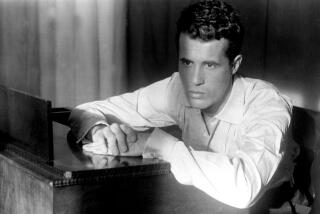MOVIE REVIEW : FILMING KUROSAWA AT WORK ON ‘RAN’ IN ‘A.K.’
- Share via
Chris Marker’s “A.K.” (at the Nuart through Wednesday) is a work of art about the making of another work of art, Akira Kurosawa’s “Ran.” And Marker, best known for “La Jetee” and “Far From Vietnam,” is a documentarian worthy of Kurosawa.
“To create is to remember,” says Kurosawa, and Marker gives us a unique opportunity to see how his unforgettable films come into being. The tall, dignified, 75-year-old Kurosawa emerges as the calm but firm and decisive leader we’d expect him to be. He has the patience to sit out adverse weather conditions and to shoot as many retakes as necessary.
He possesses the gift of being able to meditate while activity swirls all around him, plus the ability to film “seven battle scenes in the time it takes another director to shoot a poker game.” Kurosawa did not relax his ban of on-set interviews even for Marker, but the documentarian’s crew was able to tape-record the director’s random remarks to fill out their portrait of the artist.
Except for the increasing cold, Kurosawa shoots battle scenes on the slopes of snow-capped Mt. Fuji in circumstances otherwise the envy of any film maker. He’s surrounded by a totally dedicated cast and crew, key members who have been with him for years, and clearly he has at his disposal everything he needs to do anything he wants. But how hard-won have been these ideal creative conditions--and with what difficulty and increasing rarity has Kurosawa been able to obtain them. (Marker would no more state this directly than he would reveal that Kurosawa, the most reserved of men, lost his wife of more than 40 years while making “Ran.”)
So magnificent are “Ran’s” costumes and props, their vivid colors standing out against slatelike slopes and leaden skies, that Marker and his cameraman Frans-Yves Maresco have been able to create images worthy of their subject and the film he’s making. “A.K.” is a beautiful tribute to Kurosawa and his art, its mood of celebration emphasized by the string-quartet score composed by longtime Kurosawa associate Toru Takemitsu.
“A.K.” unfolds in succinct chapters, named for the natural elements and qualities that characterize Kurosawa’s films. Marker, for example, stresses the director’s love of horses and their importance in his pictures, tracing this interest all the way back to Kurosawa’s work as second-unit director on Kajiro Yamamoto’s classic “Horse” (1941). And when Marker’s narrator Robert Kramer recalls that when John Ford told Kurosawa, “You really love rain,” Kurosawa replied, “You really have looked at my films.”
Kurosawa’s attention to detail is legendary, and Marker shows it to us in depth. We’re able to see at close range, something not possible in “Ran,” the superb craftsmanship of the warriors’ costumes--the careful construction of their dark, shell-like suits of armor, the incredible amount of stitchery on their gloves. We learn that for a night scene, subsequently edited out, Kurosawa had his crew paint a field of pampas grass gold to get the effect of gold over black lacquer.
Anyone who’s seen a Kurosawa film, however, knows that such effects are never mere self-indulgence--but are there to help communicate his vision. “The essence of cinema is showing people what they want to see,” says Kurosawa, who in more than 30 films in 40-plus years has taught us to do such seeing in new ways.
More to Read
Only good movies
Get the Indie Focus newsletter, Mark Olsen's weekly guide to the world of cinema.
You may occasionally receive promotional content from the Los Angeles Times.










